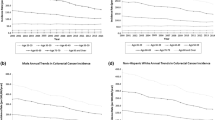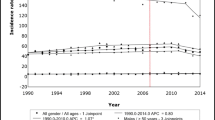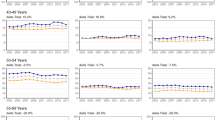Abstract
Previous studies have reported incidence and mortality declines for colorectal cancer (CRC). We evaluated recent temporal trends of colorectal cancer in the United States for the last 4 decades. Using the Surveillance, Epidemiology, and End Results (SEER) database, we identified primary CRCs diagnosed between 1973 and 2015. Temporal changes were evaluated by 6-year time periods. Age-adjusted incidence rates and annual percentage change (APC) for CRC were calculated by site and gender. Age-standardized relative survival rates were also evaluated. We identified 878,632 CRC patients, 51% of whom were men. For both genders, the proportions of new diagnoses of right-sided colon cancer (RCC) remained relatively stable, with the APC of − 0.8 and − 0.6 for the male and the female, respectively. There was a relative increase in RCC for the younger aged group (< 49 years). In contrast, the proportions of left-sided colon cancer (LCC) and rectosigmoid-cancer (RSC) decreased significantly over time. For those aged 0–49, the age adjusted incidence rates showed a small increase (in both genders), whereas age-adjusted incidence rates declined for those aged 50–64 and > 65 (in both genders). Our study showed near significance in the decline of CRC mortality rates in this population, except the 1-year age-standardized survival of LCC and RSC, and the 5-year age-standardized RCC in females. There was a significant increase in RCC for the younger aged group (< 49 years). In contrast, the proportions of LCC and RSC decreased significantly over time.

Similar content being viewed by others
References
Lao VV, Grady WM (2011) Epigenetics and colorectal cancer. Nat Rev Gastroenterol Hepatol 8:686–700
Iacopetta B (2002) Are there two sides to colorectal cancer? Int J Cancer 101:403–408
McCashland TM, Brand R, Lyden E et al (2001) Gender differences in colorectal polyps and tumors. Am J Gastroenterol 96:882–886
Cheng L, Eng C, Nieman LZ et al (2011) Trends in colorectal cancer incidence by anatomic site and disease stage in the United States from 1976 to 2005. Am J Clin Oncol 34:573–580
Cress RD, Morris C, Ellison GL et al (2006) Secular changes in colorectal cancer incidence by subsite, stage at diagnosis, and race/ethnicity, 1992–2001. Cancer 107:1142–1152
Gross CP, Andersen MS, Krumholz HM et al (2006) Relation between Medicare screening reimbursement and stage at diagnosis for older patients with colon cancer. JAMA 296:2815–2822
Ko CW, Kreuter W, Baldwin LM (2002) Effect of Medicare coverage on use of invasive colorectal cancer screening tests. Arch Intern Med 162:2581–2586
Rex DK, Eid E (2008) Considerations regarding the present and future roles of colonoscopy in colorectal cancer prevention. Clin Gastroenterol Hepatol 6:506–514
Winawer SJ, Zauber AG, Ho MN et al (1993) Prevention of colorectal cancer by colonoscopic polypectomy. The National Polyp Study Workgroup. N Engl J Med 329:1977–1981
Selby JV, Friedman GD, Quesenberry CJ et al (1992) A case-control study of screening sigmoidoscopy and mortality from colorectal cancer. N Engl J Med 326:653–657
Cook AD, Single R, McCahill LE (2005) Surgical resection of primary tumors in patients who present with stage IV colorectal cancer: an analysis of surveillance, epidemiology, and end results data, 1988 to 2000. Ann Surg Oncol 12:637–645
Katanoda K, Hori M, Matsuda T et al (2015) An updated report on the trends in cancer incidence and mortality in Japan, 1958–2013. Jpn J Clin Oncol 45:390–401
Ashley J (1990) The international classification of diseases: the structure and content of the tenth revision. Health Trends 22:135–137
Lo NS, Sarr MG (2003) Mucinous cystadenocarcinoma of the appendix. The controversy persists: a review. Hepatogastroenterology 50:432–437
Ogburn EL, Zeger SL (2016) Statistical reasoning and methods in epidemiology to promote individualized health. In celebration of the 100th anniversary of the Johns Hopkins Bloomberg School of Public Health. Am J Epidemiol 183:427–434
Soetikno RM, Kaltenbach T, Rouse RV et al (2008) Prevalence of nonpolypoid (flat and depressed) colorectal neoplasms in asymptomatic and symptomatic adults. JAMA 299:1027–1035
Matuchansky C (2009) Computed tomographic colonography for detecting advanced neoplasia. JAMA 302:1528–1529
Phillips KA, Liang SY, Ladabaum U et al (2007) Trends in colonoscopy for colorectal cancer screening. Med Care 45:160–167
Schenck AP, Peacock SC, Klabunde CN et al (2009) Trends in colorectal cancer test use in the medicare population, 1998–2005. Am J Prev Med 37:1–7
Rostom A, Jolicoeur E, Dube C et al (2006) A randomized prospective trial comparing different regimens of oral sodium phosphate and polyethylene glycol-based lavage solution in the preparation of patients for colonoscopy. Gastrointest Endosc 64:544–552
Boursi B, Halak A, Umansky M et al (2009) Colonoscopic screening of an average-risk population for colorectal neoplasia. Endoscopy 41:516–521
Siegel RL, Jemal A, Ward EM (2009) Increase in incidence of colorectal cancer among young men and women in the United States. Cancer Epidemiol Biomarkers Prev 18:1695–1698
Edwards BK, Ward E, Kohler BA et al (2010) Annual report to the nation on the status of cancer, 1975–2006, featuring colorectal cancer trends and impact of interventions (risk factors, screening, and treatment) to reduce future rates. Cancer 116:544–573
Larsson SC, Wolk A (2006) Meat consumption and risk of colorectal cancer: a meta-analysis of prospective studies. Int J Cancer 119:2657–2664
Ferrari P, Jenab M, Norat T et al (2007) Lifetime and baseline alcohol intake and risk of colon and rectal cancers in the European prospective investigation into cancer and nutrition (EPIC). Int J Cancer 121:2065–2072
Chan AT, Giovannucci EL, Meyerhardt JA et al (2005) Long-term use of aspirin and nonsteroidal anti-inflammatory drugs and risk of colorectal cancer. JAMA 294:914–923
Grodstein F, Newcomb PA, Stampfer MJ (1999) Postmenopausal hormone therapy and the risk of colorectal cancer: a review and meta-analysis. Am J Med 106:574–582
Acknowledgements
We would like to thank the native English speaking scientists of Elixigen Company (Huntington Beach, California) for editing our manuscript.
Funding
This work was supported by the National Natural Science Foundation of China (Grants 81272641, 81572409, 81472578, 81773051).
Author information
Authors and Affiliations
Contributions
Conception and design: LY, BZ, and L-PX; methodology: LY, S-SL, Z-CX; collection and assembly of data: LY, S-SL, Z-CX, H-JC, W-ZH, Q-KX; data analysis and interpretation: LY, S-SL, CJ, Q-KX; manuscript writing: all authors; final approval of manuscript: all authors. All authors (LY, S-SL, Z-CX, H-JC, W-ZH, Q-KX, CJ, BZ, L-PX) have read and approved the final manuscript.
Corresponding authors
Ethics declarations
Conflict of interest
All authors have no conflicts of interest to declare.
Ethics approval and consent to participate
As the data used were from SEER dataset, which is publicly available, ethics approval and consent to participate is not applicable.
Statement of human and animal rights
The research involving humans was carried out according to the principles of the Declaration of Helsinki.
Informed consent
Informed consent was not applicable in this retrospective study.
Additional information
Publisher's Note
Springer Nature remains neutral with regard to jurisdictional claims in published maps and institutional affiliations.
Rights and permissions
About this article
Cite this article
Yang, L., Liu, S., Xiong, Z. et al. Changes in colorectal cancer incidence by site and age from 1973 to 2015: a SEER database analysis. Aging Clin Exp Res 33, 1937–1946 (2021). https://doi.org/10.1007/s40520-020-01721-x
Received:
Accepted:
Published:
Issue Date:
DOI: https://doi.org/10.1007/s40520-020-01721-x




